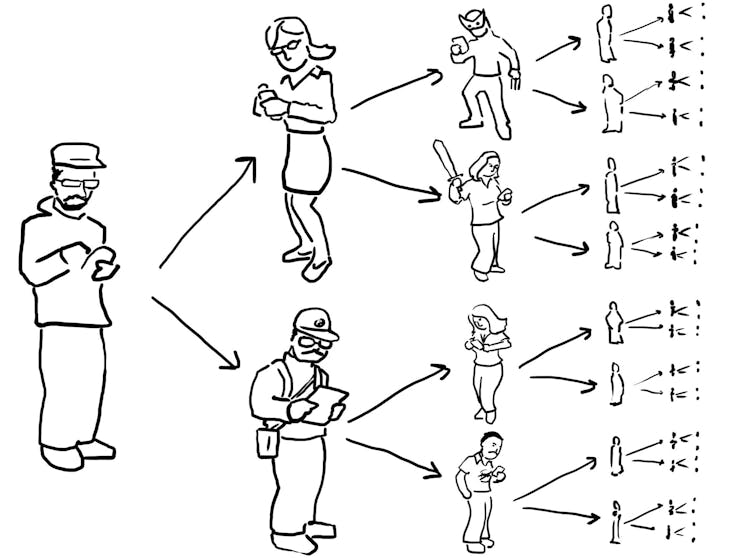Viruses have been described as “organisms at the edge of life”, unable to reproduce outside the cells of those they infect. But this status has not impeded their evolutionary success. Children, in particular, experience a multitude of viral illnesses during their early years, which gradually reduce over time as their natural immunity develops.
Viral infections may be fleeting (think influenza) or chronic (HIV, for instance), affecting various parts of the body to cause a diverse array of symptoms. These differences have important implications for the spread of that particular viral disease.
Reducing reproduction numbers
The most relevant factor is the infectiousness of a virus, often summarised in a measure known among epidemiologists as its “reproduction number”. This describes the average number of secondary infections produced by one ill individual.
Consider the most commonly transmitted viral illness, the flu: about 10% to 20% of the population is infected by one of the circulating influenza viruses each year. Symptoms vary from a mild “cold” through to severe respiratory infection requiring hospitalisation.
So it’s perhaps surprising that the reproduction number of influenza is relatively low; each infectious person infects only one and a half other people - or put another way, two infectious people produce, on average, three new cases of influenza. If we could get that reproduction number below one, incidence numbers would decline as, on average, each infected person would not necessarily produce a successor.
What makes the flu difficult to control despite its relatively low reproduction number is the fact that people are contagious for a day or two before they show any symptoms. Once they become unwell, they’re contagious for a couple more days. But by this stage they’re more likely to stay home and avoid contact with others.

As half or more of their secondary infections will have been produced before the ill people showed any symptoms, influenza control strategies that rely on identifying and isolating them aren’t necessarily going to effectively reduce the incidence of the illness in the community.
This incubation period – the time when a person is infected but not showing symptoms – is a vital consideration for controlling viral illness.
Incubating viruses
Consider the outbreak of a deadly strain of the coronavirus that caused Severe Acute Respiratory Syndrome (SARS) in 2003. Like influenza, SARS leads to fever and cough, and is mostly spread by close contact between people. Even though its reproduction number has been estimated to be between three and four, people carrying the virus are most contagious in the second week of their infection, after they have started to show symptoms of the disease.
It was this delay until contagion that made it possible to contain SARS: health-care workers were able to find and quarantine people who had contact with the disease before they infected others. Nonetheless, controlling its outbreak was not an easy task – it spread to around 30 countries and killed about 10% of those infected.
SARS appears to have been eradicated but the recently emerged Middle East Respiratory Syndrome (MERS), which also belongs to the coronavirus family, has many similarities. The majority of cases, including the recent outbreak in the Republic of Korea, have arisen from infection spread in health-care settings, where early infections are indistinguishable from other respiratory viruses.
Another virus that’s been grabbing news headlines of late is Ebola. While flu and SARS spread through coughing and sneezing, contracting Ebola requires direct contact with the blood or other bodily fluids of an infected person, or with items such as bedding or clothing contaminated with these fluids.
As with SARS, people infected with Ebola are not contagious until they begin to show symptoms, which include diarrhoea, vomiting and bleeding. Contagiousness increases as these symptoms worsen and peaks around the time of death. The body of a deceased person remains contagious after death. Safe burial practices were therefore an essential component in controlling the recent Ebola outbreak.

The reproduction number of Ebola in the latest outbreak was as high as four. But, as with SARS, the delay until contagion made it possible to trace and quarantine people who had been in contact with Ebola before they spread the disease any further.
The importance of vaccines
In stark contrast to these stories of successful disease control, the World Health Organisation estimates that 35 million people are living with human immunodeficiency virus (HIV) infection. And more than 39 million have died from the infection to date.
This toll is largely due to the fact that people with HIV infection may take anywhere between two and 15 years to develop symptoms of acquired immune deficiency syndrome (AIDS). Meanwhile, they unknowingly infect others over a period of many years, rather than days or weeks.
HIV spread can be effectively reduced by antiretroviral drugs, which lower virus levels in the blood. Unfortunately, WHO estimates that only a third of the people who need these drugs currently have access to them. Meanwhile, the quest for an HIV vaccine continues.
Vaccines, in fact, are one of the best ways to control the spread of viral illnesses. Consider the numerous childhood illnesses that are now contained thanks to vaccines.
Measles and chicken pox, for instance, are classically identifiable by their distinctive rashes. But they’re most infectious in the time between the appearance of non-specific symptoms, such as fever, runny nose and cough, and the development of this rash. This made it very difficult to control their spread until vaccines were developed.
As you can see, different viral diseases are most infectious at different times and this timing of contagiousness plays a key role in how successfully the diseases spread. Knowing a virus’ most infectious period is vital for working out the kinds of measures that are likely to work to control and perhaps even eradicate it from the community.

